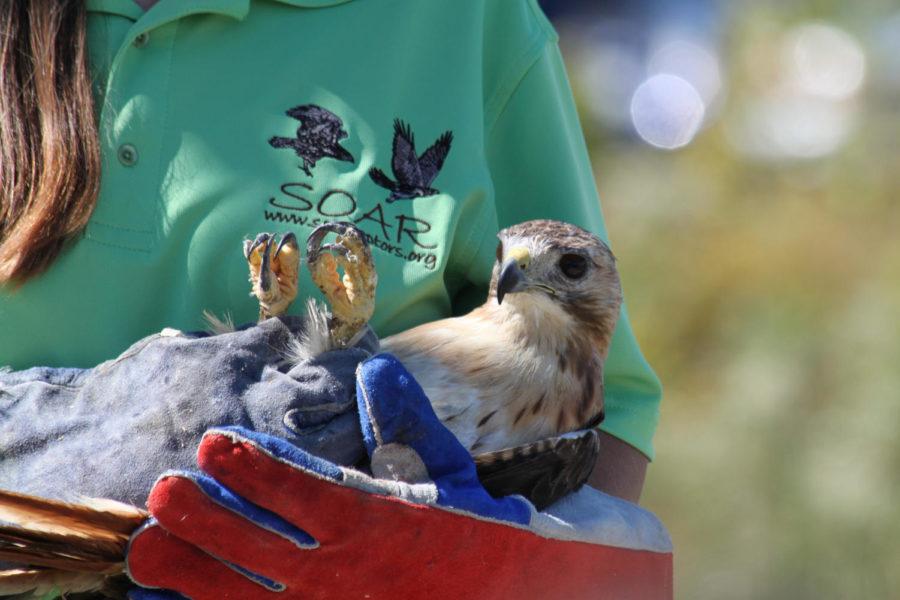Released raptors soar through McFarland Park
A yearling red tailed hawk awaits release by an Saving Our Avian Resources worker. SOAR and ISU Wildlife Care Clinic released four raptors in McFarland Park on Sept. 20.
September 20, 2015
In a rush of feathers they were off, four brown and grey spots soaring through the afternoon sky as the first annual raptor release concluded.
The Wildlife Care Clinic, Story County Conservation and Saving Our Avian Resources (SOAR) sponsored the release at McFarland Park.
SOAR released four birds: one Cooper’s hawk, one red-tailed hawk and two great-horned owls
The raptors were rehab patients of both the Wildlife Care Clinic and SOAR.
“The Care Clinic does the caring and gets the birds ready for flight,” said Kay Neumann, executive director of SOAR. “The care clinic then gives the birds to SOAR for extended flight training and preparation for release.”
Kelsey Peterson, senior in biology and undergraduate assistant at the care clinic, said about 75 percent of the birds cared for by the Wildlife Care Clinic were injured because of human activity. The most common issues are because of car collisions, wing injuries, head trauma and vision issues.
“All of these problems are life-threatening,” Peterson said. “If the bird can’t fly or see then they can’t hunt.”
To test whether the bird is ready to be released, the care clinic will perform vision tests, flight tests and will test to see if the bird is still able to hunt, Peterson said.
“The state requires the bird to have 60 percent of its vision to be released,” said Jessica Colvin, senior in animal ecology and undergraduate assistant at the care clinic.
If the bird cannot be released back into to the wild for any reason, the care clinic will try to find a home for it.
“We always try to place them [in a new home] before we humanly euthanize them,” Peterson said.
Zoos and wildlife sanctuaries are two places that will take the birds. The care clinic also keeps some of the birds for educational purposes, but it can’t keep too many because it costs too much to feed them.
Some of the birds permanently in the care of the clinic will foster some of the young birds and teach them how to survive in the wild, Peterson said.
Once the birds are released to the care of SOAR they are put in a flight pen.
“Once birds are healed up they need to exercise like an athlete,” Neumann said. “They need to stretch their muscles.”
The pens allow them to do this and allow the caretakers at SOAR to see which birds are ready to go.
“We like to spend half an hour trying to catch [the birds]. That’s when we know they are ready to be released.” Neumann said.
When the birds are ready to be released they are taken to a field like the one at McFarland Park and allowed to fly off into the wild.
Members from the audience during the release were allowed to assist Neumann as she tossed the birds into the air.
Neumann stressed that the birds were still wild animals and must be treated as such.
“This is not Hedwig, this is a wild animal,” Neumann said.
Each raptor that was released soared off into the spread of trees in the park and eventually found a tree to nestle in. One of the owls decided not to fly off when it was released and instead landed about five feet away and ran back to the group. Neumann picked it up and successfully released it.
The park the birds were released into is owned by Story County Conservation and is home to many different forms of wildlife.
The birds should thrive here, Neumann said. The conservation site is home to many creatures for the raptors to hunt and is large enough for them to not have to compete over territory.
“It takes a lot of time, patience and dedication to care for these birds, but it’s days like these that make it all worth while,” Peterson said.







